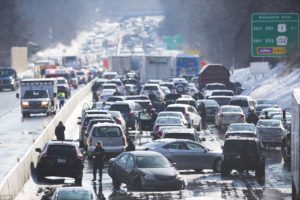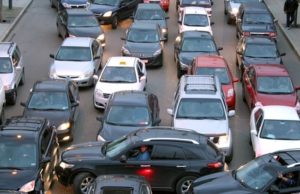Holiday Traffic and Product Delivery
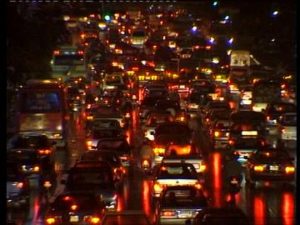 Ahhh, It’s the time of year again when I am reminded of the great metaphor of product delivery–the awe inspiring human interaction that is interstate highway holiday traffic. Hundreds of cars traveling at 75+ MPH with little more than a car length, nose to bumper and literally 2 or 3 feet clearance on a side.
Ahhh, It’s the time of year again when I am reminded of the great metaphor of product delivery–the awe inspiring human interaction that is interstate highway holiday traffic. Hundreds of cars traveling at 75+ MPH with little more than a car length, nose to bumper and literally 2 or 3 feet clearance on a side.
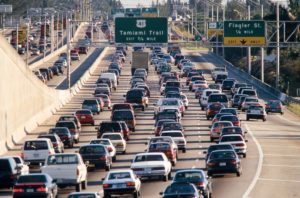 There is an implied and shared understanding among the drivers: “Don’t do anything sudden or or dangerous, and we’ll all get to where we’re going.” It’s a dance really. If you are fortunate enough to find yourself in a “super-pod” of drivers who have reached this understanding, you’ll detect the sense of camaraderie that develops. You’ll pass one another, or you’ll drift behind. Signals to come over a lane are welcomed. This happens over and over again on all of the nation’s highways. It may happen like this across the world; I don’t know.
There is an implied and shared understanding among the drivers: “Don’t do anything sudden or or dangerous, and we’ll all get to where we’re going.” It’s a dance really. If you are fortunate enough to find yourself in a “super-pod” of drivers who have reached this understanding, you’ll detect the sense of camaraderie that develops. You’ll pass one another, or you’ll drift behind. Signals to come over a lane are welcomed. This happens over and over again on all of the nation’s highways. It may happen like this across the world; I don’t know.
Yet the very mention of driving during the holidays gives most drivers a nervous eye twitch. It’s universally accepted that it is an effort requiring unparalleled patience and massively lowered expectations. Why? Because those “pods” of happy, synchronized drivers I mentioned above are actually rare. Instead, what we usually see are massive stretches of stop and go traffic. With 47 million drivers on American highways during a typical holiday, delays upon delays are commonplace. We’ll find ourselves stuck crawling for over an hour only to suddenly find ourselves back up to speed with out a single sign of what caused the delay. I’m pretty sure a common expression is: “What the hell was that about?” For some stretches of road, huge numbers of cars make it on time, yet for other portions, it’s a disaster.
The “I’ve got to be in the fast lane!”
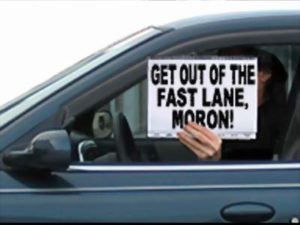 This is that driver who camps out in the fast lane and stays there until it’s time for his exit, usually less than 1/4 mile up, and insists on getting across all lanes. to get there. These drivers are like the Product Owners who insists on “fast tracking” all of their work with a release date in mind but have not communicated that date to anyone until the last minute. Like the driver who sits in the fast lane, this product owner’s projects do not allow for other work to be moved along quickly and disrupt the flow of work that truly needs to be fast-tracked. Also, like the driver who cuts everyone off to get to the exit, causing a massive number of cars to suddenly hit their brakes, the product owner inadvertently causes an abrupt slow down-if not a complete stop–to work that was in a regular pipeline. Sadly, also like the driver who feels like holiday traffic driving isn’t all that bad, the product owner is oblivious to the delays and problems caused by his or her narrow focus.
This is that driver who camps out in the fast lane and stays there until it’s time for his exit, usually less than 1/4 mile up, and insists on getting across all lanes. to get there. These drivers are like the Product Owners who insists on “fast tracking” all of their work with a release date in mind but have not communicated that date to anyone until the last minute. Like the driver who sits in the fast lane, this product owner’s projects do not allow for other work to be moved along quickly and disrupt the flow of work that truly needs to be fast-tracked. Also, like the driver who cuts everyone off to get to the exit, causing a massive number of cars to suddenly hit their brakes, the product owner inadvertently causes an abrupt slow down-if not a complete stop–to work that was in a regular pipeline. Sadly, also like the driver who feels like holiday traffic driving isn’t all that bad, the product owner is oblivious to the delays and problems caused by his or her narrow focus.
The “That’s my exit, and I’ll be damned if I have to use another.”
This driver often has not realized that his exit is coming up, and rather than adjusting to the potential of missing the exit and taking the next exit, he will slow down to dangerously low speeds and be forced to make sudden accelerations to inch his way over. Cars behind this driver all must slow to a near stop. Often, there are accidents caused by this erratic behavior. This driver is not thinking about the fact that all of the drivers on the road are in this together and that flexibility can keep more cars flowing. Some Product owners decided on a delivery date and will not modify their plan. Their inflexibility is not their biggest fault, however. Their most disruptive behavior has been to decide on a release vehicle, without signaling to anyone else impacted by that release. They have not made proper preparations to actually hit that release. Instead, at the final hour, they expect everything to shift around to accommodate promises they have made. The result again is all other work has slowed, if not stopped, to allow his work to get out in production.
The “Wide load–requires two lanes.”
 Picture the house on a trailer. It is going slower than all other traffic. All cars have to shift to get around it. While house moving can be necessary, (it might be very hard to break a house down into any smaller pieces), perhaps the move itself should be timed to fall outside the busiest driving days of the year. Big projects are just like this. They slow everything else around them down. Yes, like the truck driver who has safely and heroically delivered the whole house, the product owner who brings the big project in safely may also look like a hero for delivering something big and news-worthy, but at what expense? How many other features were not delivered? And what if it had been broken into smaller pieces that could have been delivered more rapidly, providing earlier customer satisfaction?
Picture the house on a trailer. It is going slower than all other traffic. All cars have to shift to get around it. While house moving can be necessary, (it might be very hard to break a house down into any smaller pieces), perhaps the move itself should be timed to fall outside the busiest driving days of the year. Big projects are just like this. They slow everything else around them down. Yes, like the truck driver who has safely and heroically delivered the whole house, the product owner who brings the big project in safely may also look like a hero for delivering something big and news-worthy, but at what expense? How many other features were not delivered? And what if it had been broken into smaller pieces that could have been delivered more rapidly, providing earlier customer satisfaction?
The “I don’t need to use my signals, I’m a fast driver”
This is the driver after which this post is entitled. He looks like an idiot. The sense is that he has watched one too many installments of Fast and The Furious. He doesn’t notice that every driver he cuts off must tap his or her breaks–which causes a chain reaction of traffic slow downs or stops. The Product delivery equivalent to this is the team or product owner who feels they don’t have any impact on anyone else around them, and therefore don’t need to let anyone know what they are doing or when. These People feel that they are truly nimble and the only ones who truly “get it.” Other teams must re-adjust and determine if changes the “fast and furious” team have made impact the code they have in progress. Like the speedy driver, sometimes they are right about their assumptions (and are willing to take those risks)
, but the rest of the time, they are terribly wrong and are the cause of pileups, traffic jams, and frustration all around.
The end goal for all Product owners and teams should be to keep the work flowing and getting it released to the market faster, and doing so at the enterprise level. Consider the impact your work might be having on other teams. Like driving in holiday rush hour traffic, it comes down to good communication about your intent, being considerate about other drivers, and planning your moves with plenty of room to allow the maximum number of cars to get on and off the highway. Oversized loads, if they cannot be broken into smaller multiple loads, must be planned to occur outside of heavy traffic periods. Sudden moves, erratic moves, or self centered moves may get you through the traffic, but at the expense of everyone else on the highway. Try to form your own “super-pod” of good drivers, flying down the highway delivering all of that precious cargo safely to its destination.


